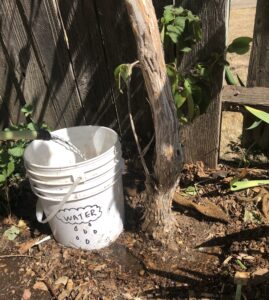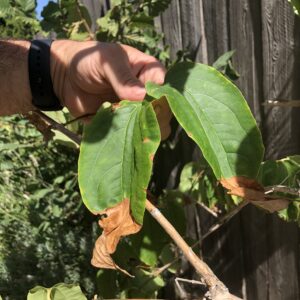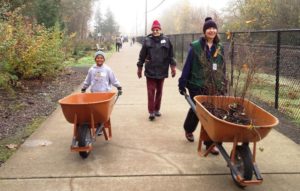Category: Dr. Tree
Simple ways to protect your tree on windy days
The Pacific Northwest is experiencing a historic windstorm event in September, 2020. These winds can cause serious damage to both young and established trees. When the winds pick up, you can take some simple steps to prevent damage to your tree friend.
What should I do to protect my trees from wind?

Wind causes leaves to dry out more quickly. That’s why it’s important to make sure tree roots have access to water in the soil to replenish the water lost through their leaves. If trees don’t have enough access to water in the soil, the leaves can dry out, and potentially cause dieback.
- Newly planted trees (1-5 years since planting): Make sure to give young trees a nice, deep soaking of the root zone with about 10-15 gallons of water. That’s three large buckets of water, slowly added to the soil. Make sure you soak all of the soil within two feet of the trunk, and imagine you are trying to reach the roots about a foot deep in the soil.
- Established trees (5+ years): This is a great job for a soaker hose or sprinkler, slowly moistening the soil around the edge of the canopy of the tree. Some mature trees are already experiencing drought stress, so it’s extra important to give them an extra drink during windy periods.

Why does my tree lose water through its leaves?
Water loss through leaves is due to a process called transpiration, which is essentially the process that occurs after your tree takes up water from the soil, uses it for photosynthesis, and then releases it back into the air. The US Geological Survey explains it this way:
“The typical plant, including any found in a landscape, absorbs water from the soil through its roots. That water is then used for metabolic and physiologic functions. The water eventually is released to the atmosphere as vapor via the plant’s stomata — tiny, closeable, pore-like structures on the surfaces of leaves.”
That water (H2O), of course, plays an important role in photosynthesis while inside the plant, reacting with carbon dioxide (CO2) to produce some delicious sugars for the plant to eat (C6H12O6) and some complimentary fresh oxygen (O2) for us!
So, why does the wind cause tree leaves to dry out more quickly?
Because water likes to distribute itself evenly, it will tend to move from a moist location to a drier location. If the inside of the leaf is moist, and the outside air is also moist, water won’t feel the need to jump ship.
But, as Wikipedia explains, “wind blows away much of this water vapor near the leaf surface…speeding up the diffusion of water molecules into the surrounding air.” The wind moves the moisture away from the leaf, encouraging more water to exit the leaf and re-moisten the surrounding air.
So, keep an eye out for dry/windy weather in the forecast, and make sure your trees and plants are prepared. And give special attention to evergreens in windy/dry periods during the winter, as these trees with year-round leaves and needles will transpire year-round as well.
Learn how trees help make us healthy
 Do you know how increased exposure to nature creates countless health benefits?
Do you know how increased exposure to nature creates countless health benefits?
Join us for a free Trees & Health event–in Portland, Salem and Eugene
Trees benefit people, creatures and the planet in ways too numerous to list here. We know that trees combat climate change, clean our air and water, create habitat, grow food … Trees do so much that it’s no surprise that trees improve our health, too—but it’s only relatively recently that we’ve learned just how much trees contribute to human health. Friends of Trees is now using that knowledge to implement programming specific to trees and health.
Thanks to a 2016 funding award from Metro, Friends of Trees has expanded our community tree-plantings to include Portland’s Northwest Industrial District, focusing on projects to directly impact human health. Our goal is adding green infrastructure to this area that has an abundance of concrete and a dearth of green. These plantings will also forge a stronger connection between the Industrial District and Forest Park, which is so close yet so disconnected from this part of town; adding trees in the industrial section contributes to a green corridor, channeling the benefits of the park to the industrial district.
How do trees make us healthy? Patients in hospitals heal more quickly if they have a view of trees and nature; people are more likely to get out and walk and run through tree-lined communities; babies in tree-lined neighborhoods are more likely to have a healthy birth weight; exposure to greenspaces can reduce blood pressure and stress levels; views of natural settings have been found to reduce crime and aggression … to list just a few.
Yes, the trees we plant here will improve our health, but so will the way we plant those trees. Our community tree-planting program is implemented with thousands of volunteers, many of whom have never volunteered before. And guess what? Volunteering is good for your health, too! Volunteering makes us happy, contributes to more satisfied employees, decreases the risk of depression, reduces stress levels, and more!
And to help these trees grow and thrive, Friends of Trees will water, mulch and prune these new trees for their first two years in the ground. This is slow and steady work, and we are excited to continue growing this program over time.
There’s another component to this project: Scientists. Presentations by experts are a part of our Trees and Health work. It’s an exciting time, with new research coming out regularly, and we look forward to sharing this important information with our community.
Learn more about trees and health.
JOIN US FOR A FREE TREES & HEALTH EVENT
Guest lecturer Dr. Kathy Wolf of the University of Washington explores how nearby nature improves environmental, social, and economic conditions in cities
- Portland, March 1, 6-7:30 p.m.
- Salem, March 2, 6-7:30 p.m.
- Eugene, March 3, 5:30-7:00 p.m.
Location and registration information.
This is an excerpt from our February Treemail, read the entire issue here.
Ask FOT: Help! My Tree is Covered in Ice.
Dear FOT: The weight of the snow and ice is causing my new trees to lean and bend over. What should I do? Will my trees be OK? I wonder how many people with taller, newer trees are going to have this problem from the ice…
-Jacob in Rose City Park, Portland

As your young tree collects ice and snow, it may gain a little winter weight. (Yep, we’ve all been there.) New trees are especially vulnerable to the extra weight, as their young, flexible branches may begin to bend under the heavy load. There are a few ways you can help your tree deal with challenging winter conditions.
Reduce the weight. If the extra weight is snow build-up, consider brushing loose snow off the trees branches with something soft, like a broom. Take care not to damage the tree’s branches. Some extra weight, like frozen ice, should not be removed from the tree. In doing so you may do more harm than good by damaging the tree’s living tissues.
Support your tree. Keep an eye on your tree during ice storms. If your tree’s branch or leader is beginning to bend, simply prop it up with a board, a bucket, a ladder, or some other kind of sturdy support to keep it from bending further and potentially breaking. If the branch is already touching the ground, it can be left in place as its weight is now being supported by the ground. If a branch is at risk of bending further, place a support under the branch to keep it from bending any lower and potentially breaking. You do not want to try to bend the tree back into shape; just prop it up a little bit to support the weight.
Prune off broken branches. If a branch has already been damaged and broken from the heavy load, you’ll want to remove the rest of a damaged branch to help the tree heal. Don’t just cut randomly; make sure to cut back to the closest branch collar. (Not sure what that means? Check out this article about proper pruning.)
Your tree should return to normal position as the ice melts off. If not, consider re-staking your tree to straighten it out. Earlier this week we re-staked some newly planted broadleaf evergreens which were uprooted from the weight of the heavy ice. They’ll probably be fine, but it’s good to correct these issues as soon as possible!
–Ian Bonham is a Neighborhood Trees Specialist at Friends of Trees
Have a tree care question? Send yours into [email protected].
Caring for your new fruit tree
We hope you can join us April 18 for our annual Fruit Tree Giveaway! A $5 donation is suggested, and even if you doubled that, you’re still escaping with a great deal on a tree.

Inexpensive is a great price point, but unlike shade trees, fruit trees require extra care and investment in the first three years.
“A young shade tree only needs to be structurally sound enough to support leaves. A fruit tree will support hundreds of pounds of fruit,” says Andrew Land, one of FoT’s staff arborists. It’s important to properly prune your new tree during the first three years of its life.”
You can call on one of our partner arborists to take care of the pruning or for the DIY inclined, visit our kindred souls at the Portland Fruit Tree Project —they’re awesome, informed, and helpful.
While pruning requires knowledge and care, there are three very important things you can do for your tree right off the bat:

1. Location, Location, Location…
If possible, choose a location on the southeast side of your property. Allow enough space for the tree to grow and plant your new tree in an area that will get plenty of sunlight. This will help both the overall health of the tree and aid in ripening fruit.
2. Thirsty, so very thirsty…
Your new tree needs 10-15 gallons of water per week. That downpour—no matter how soaked your clothes were—still doesn’t satisfy your tree’s water requirements. Fill a five gallon bucket up 2-3 times a week and give your fruit tree’s roots a deep drink.
3. #mulchmadness…
What kind of mulch? Short answer, brown: wood chips, bark dust, compost—any sort organic matter that’ll direct food and nutrients down to the roots and help retain water. Just follow the rules of 3 for mulching:
3 foot diameter of mulch
3 inches deep
3 inches from base of the trunk.
At last year’s Fruit Tree Giveaway we sold out of trees, and even with more trees on hand this year, we’d still encourage people to come out early: We’re beginning at 10 a.m. on April 18 and go through 1 p.m.
The event is held at Friends of Trees’s north parking lot at 3117 NE Martin Luther King Blvd in Portland. If you can’t make this event, you can help keep the Northwest’s tree canopy healthy by donating or volunteering.
Five winter pruning mistakes to avoid now for gorgeous, healthy trees
Winter is the ideal time to prune. Trees are dormant and have no leaves, making it easy to see branches and make good cuts. Done correctly, winter pruning creates a burst of growth in the spring—in all the right places.
On the flip side, bad pruning sets a tree up for failure. Here are five common pruning mistakes and how to avoid them this winter:

1. Topping.
Your tree’s too tall, so you lop of the top. Eek! It’s a tree’s worst nightmare. Topping immediately weakens a tree and sends it into shock repair mode to regrow its main leader in multiple places, creating a burst of bushy growth—the exact opposite effect you desired (and it’s expensive to fix). Instead, trim strong lateral branches to reduce a tree’s overall size. Here’s a video that details the evils of topping.
2. Leaving branch stubs.
“Stub cuts”—not pruning back to the branch collar (nearly the trunk)—leave trees with partially amputated limbs that don’t heal properly. This video details how to repair a stub cut.
3. Cutting too close to the trunk
“Flush cuts” remove the branch collar, a tree’s natural protection boundary. Instead of cutting flush to the trunk, leave intact the branch bark ridge and collar where the branch meets the trunk.

4. Ripping bark.
Ouch. Heavy branches can fall and rip bark before you’re done making a clean cut. To avoid this, use a three cut method.
5. Not calling the pros.
If you’re sick, you call a doctor. If you’re unsure about your tree’s health, call a certified arborist. To make it easy, we’ve got a great list of partner arborists here.
For more pruning tips, advice and free permits for street tree pruning, check out the urban forestry divisions for your city—Portland, Vancouver or Eugene.
